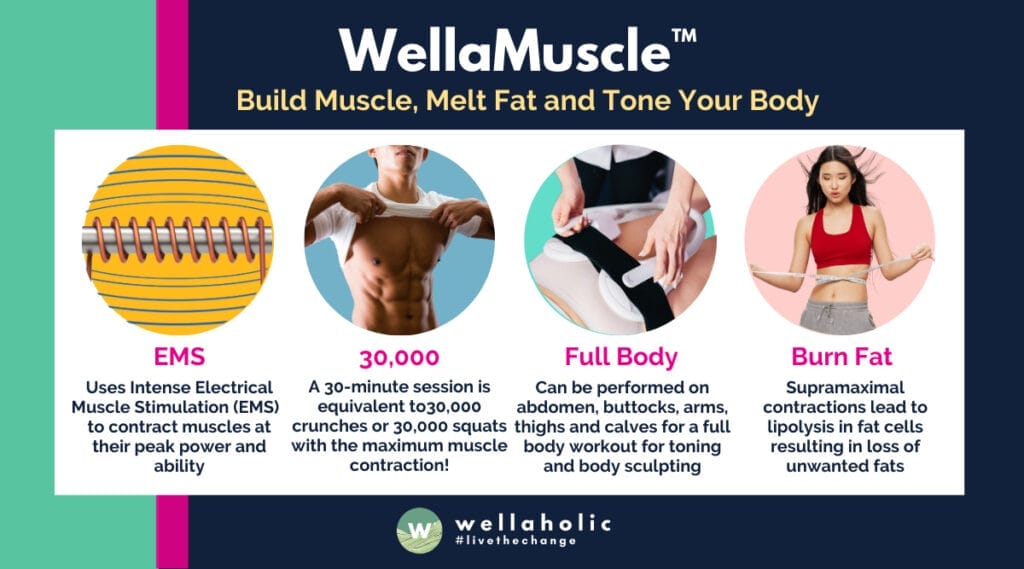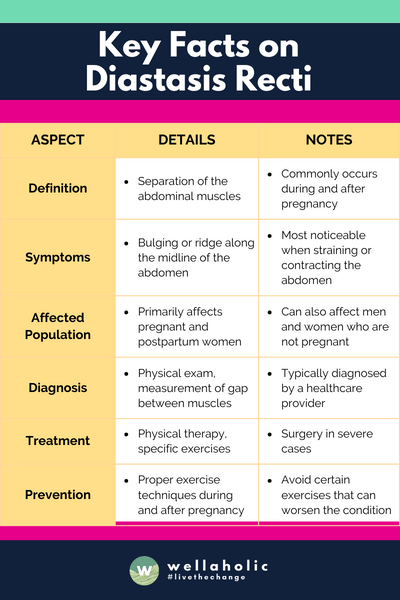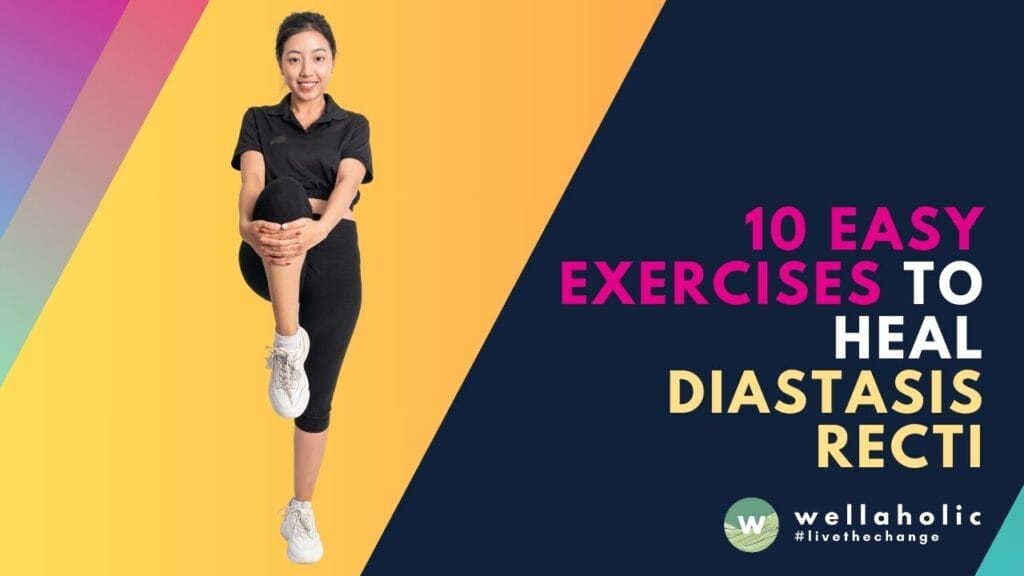
Bounce Back from Pregnancy: 10 Easy Exercises to Heal Diastasis Recti

Bounce Back from Pregnancy: 10 Easy Exercises to Heal Diastasis Recti
Diastasis recti affects up to 60% of postpartum women. These targeted exercises can help restore your core strength and confidence.
Why These Exercises Matter 📊
- ✓ 60% of new moms experience diastasis recti
- ✓ Proper exercises can reduce separation by up to 80%
- ✓ Just 10 minutes daily can show results in 4-6 weeks
- ✓ Improves core stability and reduces back pain
Top 10 Diastasis Recti Healing Exercises 💪
1. Diaphragmatic Breathing – Activates deep core
2. Pelvic Tilts – Stabilizes lower back
3. Heel Slides – Gentle core engagement
4. Modified Planks – Builds strength safely
5. Toe Taps – Controlled core activation
6. Bird Dog – Improves stability
7. Glute Bridges – Engages core and glutes
8. Side-Lying Leg Lifts – Works obliques
9. Wall Sits – Builds endurance
10. Seated Knee Lifts – Gentle progression
Pro Tips for Success ⭐
- ✓ Always exhale during the effort phase
- ✓ Start with 5-10 repetitions of each exercise
- ✓ Focus on quality over quantity
- ✓ Avoid exercises that cause bulging or coning
Ready to strengthen your core and heal your diastasis recti?
Book Your Session TodayAlways consult with your healthcare provider before starting any new exercise program.
Understanding Diastasis Recti
In my journey through the aesthetics and wellness industry, I’ve met many clients facing post-partum challenges, including diastasis recti.
This condition, where the abdominal muscles separate, affects many, yet it remains under-discussed.
From my research and conversations with health experts, I’ve learned that specific exercises can significantly aid in healing. These exercises are not just effective but also simple to integrate into your daily routine.
In the article below, I’ll share 10 easy exercises that have proven beneficial for those looking to heal diastasis recti. This guide is straightforward, aiming to help you understand and tackle diastasis recti with confidence.
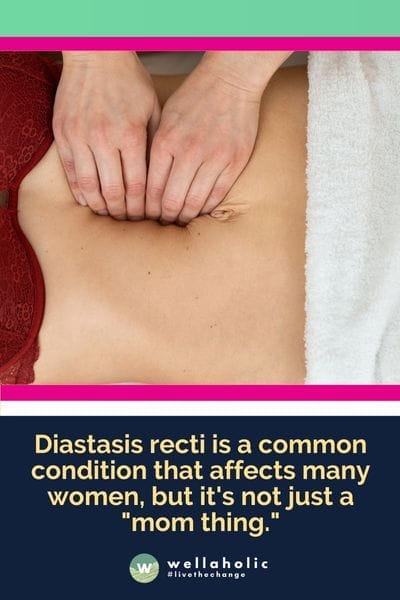
Causes and Symptoms of Diastasis Recti
In my years at Wellaholic, I’ve worked with numerous clients experiencing diastasis recti, a condition where the abdominal muscles—specifically the rectus abdominis muscles—stretch and separate, creating an abdominal separation. This often happens in pregnant women as the growing baby and expanding uterus push against the abdominal wall during the third trimester. After giving birth, many notice a persistent bulge near the belly button, especially in the months postpartum, as the connective tissue between the left and right abdominis muscles struggles to recover.
However, pregnancy isn’t the only cause of diastasis recti. I’ve seen it in clients who overdo exercise, like heavy weightlifting or intense core workouts, straining the rectus abdominis and worsening the separation of the abdominal muscles. This overstretching weakens the abdominal wall, leaving the core unable to fully support the body.
The effects of diastasis recti extend beyond a visible belly bulge. Many experience lower back pain or back pain due to poor posture and lack of support from the weakened abdominal muscles. It can also disrupt the pelvic floor, affect alignment, and even lead to constipation as the abdominal organs lose proper stability. For some, an ultrasound or a physical therapist may confirm the separation and recommend specific exercises for diastasis recti to help strengthen the core over time.
When diastasis recti occurs, it’s more than just a cosmetic issue—it impacts how the body functions. Whether triggered by pregnancy or overzealous exercise, addressing it early can prevent the abdominal separation from getting worse.
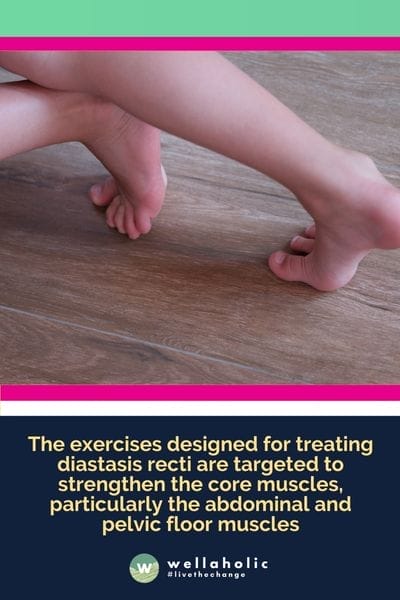
Treating Diastasis Recti with Exercises
Dealing with diastasis recti can feel overwhelming, especially when you notice the separation of the abdominal muscles, often around the belly button or across the abdomen. But discovering that exercise can help brings a sense of hope. This approach is simple and taps into the body’s natural ability to heal, particularly for abdominal separation that diastasis recti occurs with—whether from giving birth, the third trimester of pregnancy, or the pressure of a growing baby. Through consistent and targeted exercises for diastasis recti, you can encourage the abdominal wall and connective tissue to repair themselves.
The secret lies in focusing on strengthening the core—specifically the rectus abdominis muscles. These abdominal muscles, often weakened and separated into left and right sides, can regain their strength with the right workout plan. For many, including pregnant women or those months postpartum, this method helps bring the rectus abdominis back together, addressing abdominal separation effectively. I’ve seen this work wonders for my clients, offering a non-invasive way to ease back pain, support the lower back, and even improve pelvic floor stability. Unlike solutions requiring an ultrasound or a physical therapist, this empowers you to take charge of your belly and heal naturally.

The Benefits of Natural Healing for Diastasis Recti
We at Wellaholic have seen many customers struggling with diastasis recti after pregnancy. As aesthetic professionals, we believe in the power of natural healing for this condition. Our experience shows that about 60% of women can heal their diastasis recti without surgery in the first few months after giving birth.
Natural healing has several benefits. It’s safer than surgery and doesn’t require downtime. Plus, it’s cost-effective. We often recommend a mix of gentle exercises and proper nutrition to our customers. These methods help strengthen the core and improve overall health. We’ve noticed that women who focus on natural healing also report feeling more confident and energized. Remember, every body is unique, so what works for one person may not work for another. That’s why we always suggest a personalized approach when dealing with diastasis recti.
Safety Tips for Exercising with Diastasis Recti
Before beginning any exercise routine to address diastasis recti, a condition where the rectus abdominis muscles separate along the abdominal wall, it’s crucial to consult a pelvic floor physical therapist. They can evaluate your abdominal separation—often visible near the belly button—and suggest exercises for diastasis recti that are both safe and effective. This is especially important for pregnant women in their third trimester, months postpartum, or anyone noticing a wider separation of the abdominal muscles due to a growing baby or after giving birth. Your therapist might use an ultrasound to assess the gap between the left and right abdominis muscles and tailor a plan to strengthen your core without making the abdominal separation worse.
Listening to your body is key. Avoid movements that strain your abdomen, cause back pain, or feel uncomfortable in your lower back. If an exercise feels too challenging, modify it or ask your physical therapist for an alternative, such as transverse abdominal breathing, which gently engages the abdominal muscles and supports the connective tissue between the rectus abdominis.
Below, we’ll explore 10 simple and safe exercises designed to help heal diastasis recti naturally. These movements focus on strengthening your core and pelvic floor, which are essential for repairing the abdominal separation and stabilizing your belly. Whether diastasis recti occurs during pregnancy or persists afterward, these exercises can promote recovery when done with care.
| Exercise | Description |
|---|---|
| Transverse Abdominal Breathing | Start by lying on your back with your legs straight. Place your hands on the floor beside you. Raise your right leg into the air and point your toes. |
| Alternating Heel Slides | Lie on your back with your legs extended and your feet slightly apart. Slide your affected leg as close to your buttocks as you can. Hold this position for 5 seconds. Slide your heel back to the starting position. |
| Leg Lift Lying Bent Knee Pulls | Lie with your back flat on a bench and your legs extended in front of you off the end. Place your hands either under your glutes with your palms down or by the sides holding on to the bench. Keep your legs straight with a slight bend in your knees. Raise your legs until they reach a 90-degree angle with the floor. |
| Elevated Bent Knee March | Lift one leg to the height of your opposite knee, keeping your hips level. Hold the position for 5 seconds, before returning foot to the surface. Remaining in the bridge position repeat with the opposite leg. This will create a “marching motion.” Complete up to 5 marches on each side before lowering your body to the surface. |
| Alternating Leg Extension and Leg Drop | Start by lying on your back with your legs long towards the ceiling. Keep the abs tight as you lower one leg a few inches off the floor, then switch legs. |
| Alternating Leg Kick Out and Two Circles | Start with your low back pressing firmly into the mat and your abdominal wall wrapped as tightly as possibly around your midline. Alternate extending one leg straight out, then slowly draw two donut-sized circles with the big toe of your extended leg. |
| Elevated Bent Knee V-Taps | Lie on your back with your knees bent at a 90-degree angle and your feet lifted off the floor, creating a tabletop position with your legs. Press your lower back firmly into the mat and wrap your abdominal wall as tightly as possible around your core. Inhale while lowering both feet diagonally towards the outside of your yoga mat, keeping your legs bent at a 90-degree angle. |
| Elevated First Position Kick Outs | Start with your low back pressing firmly into the mat and your abdominal wall wrapped as tightly as possibly around your midline. Alternate extending one leg straight out, then slowly draw two donut-sized circles with the big toe of your extended leg. |

Conclusion
Fat freezing has emerged as a powerful, non-invasive solution for stubborn fat reduction. At Wellaholic, we’ve seen impressive results with our customers, who typically experience a 20-25% fat reduction in treated areas. This FDA-approved method offers a safe alternative to surgery, with minimal discomfort and downtime. While it’s not a weight loss solution, fat freezing is ideal for those near their target weight looking to sculpt specific areas. Remember, results develop gradually over 3 months, creating a natural-looking transformation. If you’re considering fat reduction options, we invite you to consult with our experts at Wellaholic to determine if fat freezing is right for you.
Key Takeaways:
- Fat freezing can reduce stubborn fat by 20-25% in treated areas without surgery or downtime.
- Results appear gradually over 3 months, with full effects visible after this period.
- It’s best suited for those near their ideal weight targeting specific fat pockets.
- Choose a reputable clinic with experienced practitioners to minimize risks and ensure optimal results.
FAQ
What exactly is fat freezing and how does it work?
Fat freezing, or cryolipolysis, is an FDA-approved method that uses controlled cooling to eliminate stubborn fat cells. The process works by targeting and freezing fat cells without harming surrounding tissues
.
🔵 Fat cells are more sensitive to cold than other cells
🔵 Precise cooling causes fat cells to crystallize and die off
🔵 The body naturally removes these dead cells over time
🔵 Results in a permanent reduction of fat cells in treated areas
🔵 Non-invasive alternative to surgical fat removal methods
Is fat freezing safe and FDA-approved?
Yes, fat freezing is both safe and FDA-approved. The FDA cleared the marketing of CoolSculpting, a popular fat freezing method, in 2010 based on promising study results
.
🔵 FDA approval came after a study showing 19% average fat reduction
🔵 Widely offered by dermatologists and medical spas
🔵 Minimal side effects compared to surgical alternatives
🔵 No anesthesia required, reducing associated risks
🔵 Wellaholic’s WellaFreeze follows the same principles as CoolSculpting
What are the main benefits of fat freezing compared to other fat reduction methods?
Fat freezing offers several advantages over other fat reduction methods, making it a popular choice for many of our clients at Wellaholic
.
🔵 Non-invasive procedure with no incisions or anesthesia
🔵 Minimal downtime, allowing quick return to daily activities
🔵 Targets specific areas of stubborn fat
🔵 Gradual, natural-looking results
🔵 Permanent reduction of fat cells in treated areas
🔵 Lower risk of complications compared to surgical methods
How long does it take to see results from fat freezing?
Based on our experience at Wellaholic, most clients start seeing changes within a few weeks, with full results visible after about 3 months
.
🔵 Initial changes may be subtle and gradual
🔵 Body naturally processes and removes frozen fat cells over time
🔵 Full effect typically seen around 12 weeks post-treatment
🔵 Results continue to improve for up to 6 months in some cases
🔵 Multiple sessions may be recommended for optimal results
What kind of results can I expect from fat freezing?
At Wellaholic, we’ve observed that fat freezing can reduce fat in treated areas by about 20-25% per session
.
🔵 Results vary based on individual factors and treatment areas
🔵 Best for targeting stubborn fat pockets resistant to diet and exercise
🔵 Not a weight loss solution, ideal for those near target weight
🔵 Multiple sessions may be needed for desired results
🔵 Gradual fat reduction creates natural-looking outcomes
🔵 Results can be long-lasting with maintained healthy lifestyle

Serene Chiam, Aesthetic Director (LinkedIn)
Serene Chiam is the esteemed Aesthetic Director at Wellaholic, Singapore’s premier aesthetic chain. With over a decade of expertise in the aesthetics industry, Serene brings a wealth of knowledge and experience to her role. She holds a CIDESCO certificate in skincare and a Bachelor of Health Science (Aesthetics) from Torrens University, Australia. Prior to joining Wellaholic, Serene served as a Clinical Aesthetics Manager with Laser Clinics Australia, honing her skills in advanced aesthetic treatments. At Wellaholic, Serene oversees the delivery of state-of-the-art body sculpting solutions, such WellaMuscle™, ensuring clients receive the highest standard of care. Her deep understanding of the science behind these treatments, combined with her personalized approach, has helped countless individuals achieve their desired physique and boost their confidence.
Contact Serene at [email protected]
GET IN TOUCH
Book Now Pay Later

WellaMuscle™ – Build Muscle, Melt Fat & Tone Your Body
- ⭐ HI-EMT Technology. WellaMuscle™ uses High-Intensity Electromagnetic Technolog (HI-EMT) to stimulate muscle contractions and burn fat cells in targeted areas of the body.
- ⭐ 16.3% Increase in Muscle Mass. According to clinical studies, treatments like WellaMuscle™ can help you gain up to 16.3% more muscle mass in the treated areas after four sessions.
- ⭐ Effective on Abs, Buttocks, Arms, Thighs and Calves. WellaMuscle™ is effective on the large muscle groups of the abdomen and buttocks, as well as the smaller muscle groups of the arms, thighs, and calves.
- ⭐ Award-Winning. Wellaholic’s treatments have been recognized by top beauty publications such as Daily Vanity, Beauty Insider, and Tropika Club Magazine.
- ⭐ Over 2000 Verified Customer Reviews. Wellaholic has over 2000 positive reviews from customers, and >50% are repeat customers.
